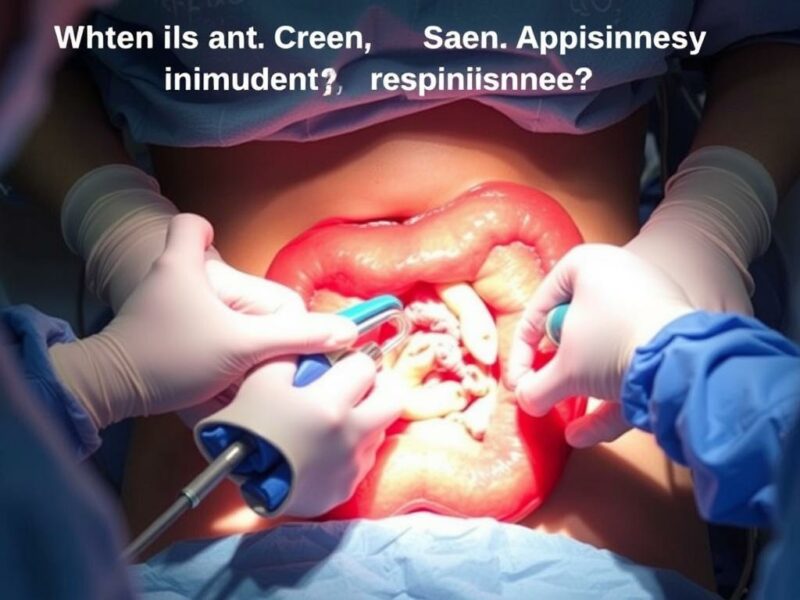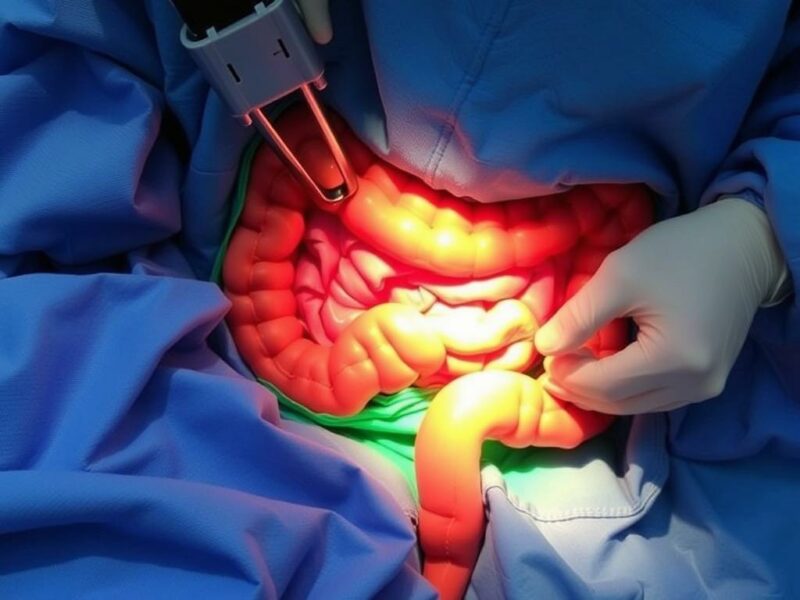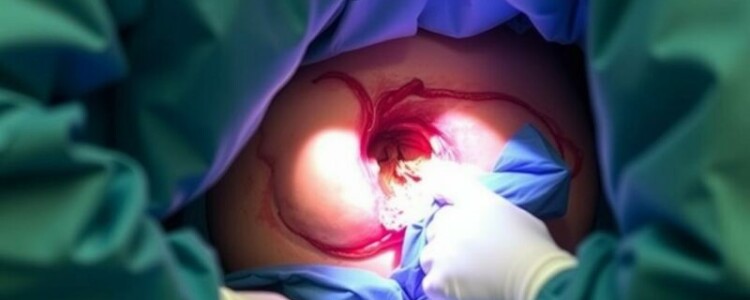What Is an Open Appendectomy?
An open appendectomy is a surgical procedure performed to remove the appendix when it becomes inflamed or infected, a condition known as appendicitis. Unlike a laparoscopic appendectomy, which uses small incisions and a camera, the open method involves a larger single incision in the lower right abdomen to access and remove the appendix directly. This traditional approach to appendix removal has been used for decades and remains essential in certain cases where laparoscopic surgery may not be suitable.
Many patients and their families want to understand what an open appendectomy entails, why it might be necessary, and what to expect during recovery. Whether you’re a medical student, a patient curious about your upcoming surgery, or simply interested in learning more about this common procedure, this article covers everything you need to know from the initial diagnosis to the post-operative care.
When Is an Open Appendectomy Recommended?

The decision to perform an open appendectomy rather than a laparoscopic one depends on various factors. Typically, surgeons recommend the open approach in situations such as:
- Complicated appendicitis with abscess or rupture
- Severe infection or inflammation spreading beyond the appendix
- Previous abdominal surgeries causing scar tissue
- Patient’s body habitus or other medical conditions
- Situations where laparoscopic tools may not be available or effective
In these cases, the open method offers direct visualization and better access to the affected area, which can be crucial for removing infected tissue and ensuring the infection does not spread.
The Surgical Process: Step-by-Step
Understanding the process of an open appendectomy can help reduce anxiety and prepare patients for what to expect. Let’s walk through the main steps of the surgery:
- Preparation: The patient is typically given general anesthesia, ensuring they are fully asleep and pain-free during the procedure. The surgical site is cleaned and sterilized.
- Incision: A single incision, usually 2 to 4 inches long, is made in the lower right quadrant of the abdomen, often called the McBurney’s point.
- Exposure: The surgeon carefully retracts the tissues and muscles to reach the inflamed appendix.
- Removal: The appendix is identified, tied off close to its base to prevent leakage, and removed.
- Inspection and Cleaning: The surrounding area is inspected for signs of infection or abscess. If necessary, the surgeon cleans the area to prevent future complications.
- Closing the Incision: The layers of muscle, tissue, and skin are sutured or stapled shut.
This surgery typically takes about 30 to 60 minutes, though the time can vary based on the patient’s condition.
Benefits and Risks of Open Appendectomy
Like any surgical procedure, an open appendectomy has its advantages and potential drawbacks. It’s important to understand both.
Benefits
- Direct Access: The open incision provides clear visibility to the appendix and surrounding tissues, which is particularly useful in complicated cases.
- Better for Ruptured Appendicitis: When the appendix has ruptured, the open method allows thorough cleaning of the abdominal cavity to reduce infection risks.
- Lower Cost and Equipment Needs: It usually requires less specialized equipment compared to laparoscopy.
Risks
- Longer Hospital Stay: Recovery may involve a longer hospital stay compared to laparoscopic surgery.
- Bigger Scar: The incision is larger and may leave a more noticeable scar.
- Increased Pain: There is often more post-operative pain due to the size of the incision.
- Potential for Infection: As with any surgery, there is a risk of wound infection and complications.
Understanding these factors helps patients make informed decisions along with their healthcare providers.
Recovery After Open Appendectomy
Recovery after an open appendectomy tends to take longer than with laparoscopic surgery, but most patients can return to normal activities after a few weeks. Here’s what the recovery journey looks like:
Hospital Stay
Most patients stay in the hospital for 2 to 5 days after an open appendectomy, depending on how complicated the appendicitis was and whether there were any post-operative complications. During this time, medical staff will manage pain, monitor for signs of infection, and encourage breathing exercises to prevent lung infections.
Post-Operative Care at Home
Once discharged, patients should:
- Keep the incision clean and dry.
- Avoid heavy lifting and strenuous activities for at least 4 to 6 weeks.
- Follow up with the surgeon to monitor healing and remove sutures or staples if necessary.
- Watch for symptoms like fever, severe pain, redness, or drainage from the incision site and report these promptly.
- Eat a balanced diet and stay hydrated to support the healing process.
Managing Pain and Discomfort
Pain is a natural part of recovery, but effective pain management helps patients feel better and resume activity sooner. Doctors typically prescribe pain relievers, and patients are encouraged to use them as directed. Additionally, applying an ice pack to the incision area and resting can help reduce swelling and discomfort.
Comparing Open Appendectomy to Laparoscopic Appendectomy
It’s helpful to look at how open appendectomy compares to the laparoscopic option, which has become increasingly popular.
| Aspect | Open Appendectomy | Laparoscopic Appendectomy |
|---|---|---|
| Incision Size | 2-4 inches | Several small incisions (0.5-1 cm each) |
| Hospital Stay | 2-5 days | Usually 1-2 days |
| Post-Op Pain | Moderate to high | Lower |
| Recovery Time | 4-6 weeks | 1-3 weeks |
| Suitability | Best for ruptured or complicated appendicitis | Best for simple appendicitis |
| Cost | Lower generally | Higher due to equipment and technology |
As the table shows, both methods have their place in modern medicine. The choice depends largely on the patient’s condition and surgeon’s expertise.
Possible Complications and How They Are Handled
No surgery is without risks. In the case of an open appendectomy, possible complications include:
- Infection: Both at the incision site and inside the abdomen. Treated with antibiotics and sometimes wound care.
- Bleeding: Usually minor but can require intervention in rare cases.
- Injury to nearby organs or tissues: Rare but possible during surgical access.
- Abscess Formation: Collections of pus that may require drainage.
- Hernia at the incision site: Due to weakness in the abdominal wall.
Post-operative monitoring is crucial for early detection and treatment of these complications.
How to Prepare for an Open Appendectomy

While many appendectomies happen on an emergency basis, sometimes the procedure is planned or semi-planned. Preparation tips include:
- Discuss any allergies, current medications, and medical history with your surgeon.
- Inform your doctor if you are pregnant or suspect you might be.
- Follow fasting instructions before the surgery—usually no food or drink after midnight the night before.
- Arrange for someone to drive you home and assist during the early recovery period.
- Understand the procedure and ask questions to alleviate anxiety.
Good communication with your healthcare team makes the experience smoother and safer.
Frequently Asked Questions About Open Appendectomy
Is an open appendectomy painful?
While the surgery itself is done under anesthesia and is painless, patients commonly experience moderate pain after the procedure, especially around the incision site. Pain management strategies are provided to ease discomfort.
How long does it take to recover from an open appendectomy?
Recovery time is generally 4 to 6 weeks, depending on your overall health and whether there were complications during surgery.
Will there be a large scar?
The open appendectomy results in a larger scar compared to laparoscopic surgery, typically a 2-4 inch vertical or oblique scar on the lower right abdomen.
When can I return to work or school?
Most patients can return to light activities within 2 to 3 weeks, but heavy lifting and strenuous exercise should be avoided for 4 to 6 weeks.
Can an open appendectomy be done if the appendix has ruptured?
Yes, open appendectomy is often preferred for ruptured appendices as it allows better access for cleaning the abdominal cavity.
Open Appendectomy: A Time-Tested Procedure with Modern Importance
Despite advancements in minimally invasive surgery, the open appendectomy remains a critical tool in the surgical arsenal. It provides a reliable and effective way to treat appendicitis, particularly when the condition is complicated or when anatomical challenges exist. Understanding the ins and outs of the open appendectomy not only prepares patients for what to expect but also highlights the importance of swift surgical intervention for the best outcomes.
Summary Table: Open Appendectomy At a Glance
| Category | Details |
|---|---|
| Purpose | Remove inflamed or infected appendix |
| Incision | Single 2-4 inch incision in lower right abdomen |
| Anesthesia | General anesthesia |
| Duration | 30 to 60 minutes |
| Hospital Stay | 2 to 5 days |
| Recovery Time | 4 to 6 weeks |
Conclusion
In the spectrum of appendicitis treatment, an open appendectomy stands as a fundamental procedure offering both safety and reliability. While it might involve a longer recovery time and a more noticeable scar compared to laparoscopic techniques, its role remains vital, especially when facing complicated or advanced appendicitis. The knowledge of what happens during the surgery, the benefits and risks, and the recovery process can empower patients and caregivers alike. Open appendectomy is more than just a surgical technique; it is a life-saving intervention that has evolved over time but still holds a crucial place in surgical practice today. With proper care and follow-up, most patients return to their normal lives swiftly, appreciating the value of timely treatment and skilled surgical care.



